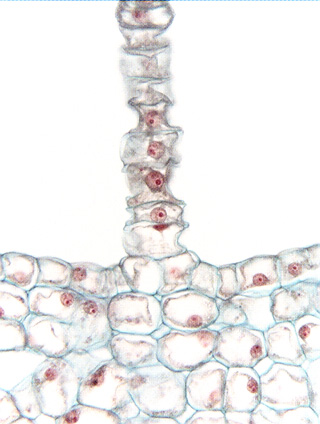Up
Ordinary epidermis
Guard cells
Thick cuticle
Thicker cuticle
Thin cuticle
Parasitic plant
Petal epidermis
Sclerified epidermis
Papillose epidermis
Sculptured cuticle
Elaborate cuticle
Cuticular horns
Radial walls
Cuticle proper
No epidermis
Epidermal peels
Cycad peel
Paradermal
Typical stoma
Sunken stoma
Stomatal orientation 1
Unusual orientation 2
Artifact
Stomata and fibers
Stomatal crypts
Crypts, mag.
Crypt margin
Non-crypt
Water lily
Stomatal channels
Groove, hi mag
Subsidiary cells
Ledges
Papillae
Trichome
Uniseriate hair
Peltate hair, mag
Peltate, lo mag
Branched hairs
Trichome base
Lithocyst, Ficus
Lithocysts, hemp
Bulliform cells
Grass epidermis
Multiple epi
Uniseriate?
Peperomia
| |
 Fig.
10.4-3.
Transverse section of wild ginger (Asarum canadense in the Aristolochia
family, not a real ginger). The cells of this uniseriate trichome are slightly
collapsed, probably an artifact. Notice the alignment of the cells: this trichome developed by cell divisions in which
all new walls were perpendicular to the long axis of the trichome.
That orientation though is at right angles to the divisions that occurred as the
protoderm was developing into the epidermis. About nine trichome cells are
visible in just this micrograph, and probably each would have lengthened greatly
during maturation, creating a long trichome. Fig.
10.4-3.
Transverse section of wild ginger (Asarum canadense in the Aristolochia
family, not a real ginger). The cells of this uniseriate trichome are slightly
collapsed, probably an artifact. Notice the alignment of the cells: this trichome developed by cell divisions in which
all new walls were perpendicular to the long axis of the trichome.
That orientation though is at right angles to the divisions that occurred as the
protoderm was developing into the epidermis. About nine trichome cells are
visible in just this micrograph, and probably each would have lengthened greatly
during maturation, creating a long trichome.
|
 Fig.
10.4-3.
Transverse section of wild ginger (Asarum canadense in the Aristolochia
family, not a real ginger). The cells of this uniseriate trichome are slightly
collapsed, probably an artifact. Notice the alignment of the cells: this trichome developed by cell divisions in which
all new walls were perpendicular to the long axis of the trichome.
That orientation though is at right angles to the divisions that occurred as the
protoderm was developing into the epidermis. About nine trichome cells are
visible in just this micrograph, and probably each would have lengthened greatly
during maturation, creating a long trichome.
Fig.
10.4-3.
Transverse section of wild ginger (Asarum canadense in the Aristolochia
family, not a real ginger). The cells of this uniseriate trichome are slightly
collapsed, probably an artifact. Notice the alignment of the cells: this trichome developed by cell divisions in which
all new walls were perpendicular to the long axis of the trichome.
That orientation though is at right angles to the divisions that occurred as the
protoderm was developing into the epidermis. About nine trichome cells are
visible in just this micrograph, and probably each would have lengthened greatly
during maturation, creating a long trichome.